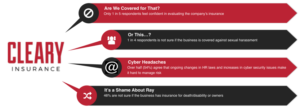Ways to Foster Workplace Wellness
Managing an office that promotes a healthy work-life balance is a trial-and-error process. Between constant accessibility as a result of technology and the pressure to meet deadlines, employee and workplace wellness is too often compromised.
It may not seem like your responsibility, but you want to encourage your employees to balance their personal and professional wellness. Some of the most successful companies in the country are investing in their employees’ wellness.
We’re here to help. Below are five ways to implement workplace wellness in your office.
Get up and active
Identify a workout studio that is close to your office location and attend a class as a group. Encourage people to initiate fitness groups within the office, or opt for walking meetings. Apps like Eventbrite and Groupon sometimes post special deals for companies looking to explore fitness.
Professional and continuing education
Employee and workplace wellness is not always about physical health – it includes mental, intellectual, and emotional. Remind your employees that their careers and growth are important to you. You can show that you mean it by going the extra mile and getting your employees in touch with wellness professionals from the likes of LeggUp (https://www.leggup.com/) or similar coaching platforms, and help them unload mentally to stay sane. Furthermore, you can offer to cover the cost of educational workshops and classes that will help people improve the work they do and strengthen their confidence in their trades. You can read up on blogs such as https://www.edenhealth.com/blog/what-are-employee-benefits/ to learn more about the aspects of employee benefits that could be integrated into the corporate culture.
Keep hydrated and improve workplace snacking options
That third cup of coffee is doing nothing to hydrate you. Water is extremely important to keep your body healthy – from your skin to your kidneys to your blood pressure – and often goes by the wayside during the busy day. Design company water bottles as a friendly reminder to your employees to prioritize hydration. If the budget allows, invest in a flavored water dispenser like this one.
Mandatory mental health days
Well, maybe not mandatory, but employers can do a much better job emphasizing the importance of mental health days. Your employees are hard-working and don’t want to be seen as slackers, though they might very much need a personal day every so often. Drop hints that you are understanding as an employer and encourage your staff to take time when they need it.
Modernize your desk and other office furniture
The research is in: desks are not healthy. Employees are often seen to be complaining about the issues in the office’s furniture, poor utilization of workspace, and absence of recreational places. For the employer, sometimes, these problems might not seem genuine, however, when ignored for a long period, it can affect the productivity of the employees. An office interior design expert might help with easy solutions for problems such as these. Also, did you know that some companies are replacing their chairs with a yoga balls as a way to fix employees’ posture and burn calories? Others are opting for adjustable desks, which allow workers to sit or stand. Both of these options often result in an increase in productivity and decrease in back pain. All in all, one must know that good office equipment and furniture could prove to go a long way in improving posture and overall health!
Get some sunshine
Encourage your employees to get their daily dose of vitamin D when the weather allows for it. Set an example by eating lunch outside or making it known that you are going for a walk.
The bottom line is this: employee and workplace wellness is not optional, it’s essential. Not only will it help your employee retention, but an increase in productivity and workplace happiness will only benefit your business.

